

We may earn revenue from the products available on this page and participate in affiliate programs. Learn More ›
Most garages aren’t designed to stay warm inside when outdoor temperatures are frigid. Garages usually lack insulation, and their concrete floors remain chilly all year around. Even with a small space heater running, the temperature inside the garage probably won’t rise more than a few degrees.
When the air inside your garage is bitterly cold, it’s not just the DIYer who doesn’t function well: Tools are icy, paints and glues won’t bond properly, and automotive repairs and woodworking tasks can be difficult to complete. To be able to tinker in your garage in all seasons, not just the warm ones, combine some of these tips for heating the garage to a comfortable temperature. You’ll have a productive work space, whatever the weather.
1. Choose a portable space heater (or two) that’s properly sized for the garage’s square footage.
Visit your local home improvement store in late fall, and you’ll find aisles of portable energy-efficient space heaters, both large and small. Most of these options, however, aren’t powerful enough to heat an entire garage. If you’re looking for a serious heat source, consider installing a ceiling-mounted forced-air heating unit such as the hardwired Dr. Infrared 7,500-Watt Garage Heater, or Comfort Zone Garage Heater, confirming, of course, that the heater model you choose is adequately sized for the square footage of your garage. This type of heater is best situated in a corner of the garage, pointed downward at a 45-degree angle to provide the best distribution of warmth. Most of today’s ceiling-mounted garage heaters come with a remote control and a thermostat so you can set the temperature you prefer and rely on the shop heater to do the rest. For other terrific heater options, refer to our tested guide to the best garage heaters.
The only real downside to a ceiling-mounted heater is that the inches nearest the floor may remain cold. If your feet are still chilly, try supplementing with a baseboard heater placed where you’re most apt to be working—one likely spot is the area beneath your workbench. Hydronic baseboard heaters like the Slant/Fin Fine/Line 30 Series Hot Water Baseboard Heater are hooked up to a home’s boiler. As hot water runs through the pipes in the heater, warm air radiates out into the space, keeping things toasty at floor level and beyond.
2. Insulate the walls with fiberglass batt and paneling.
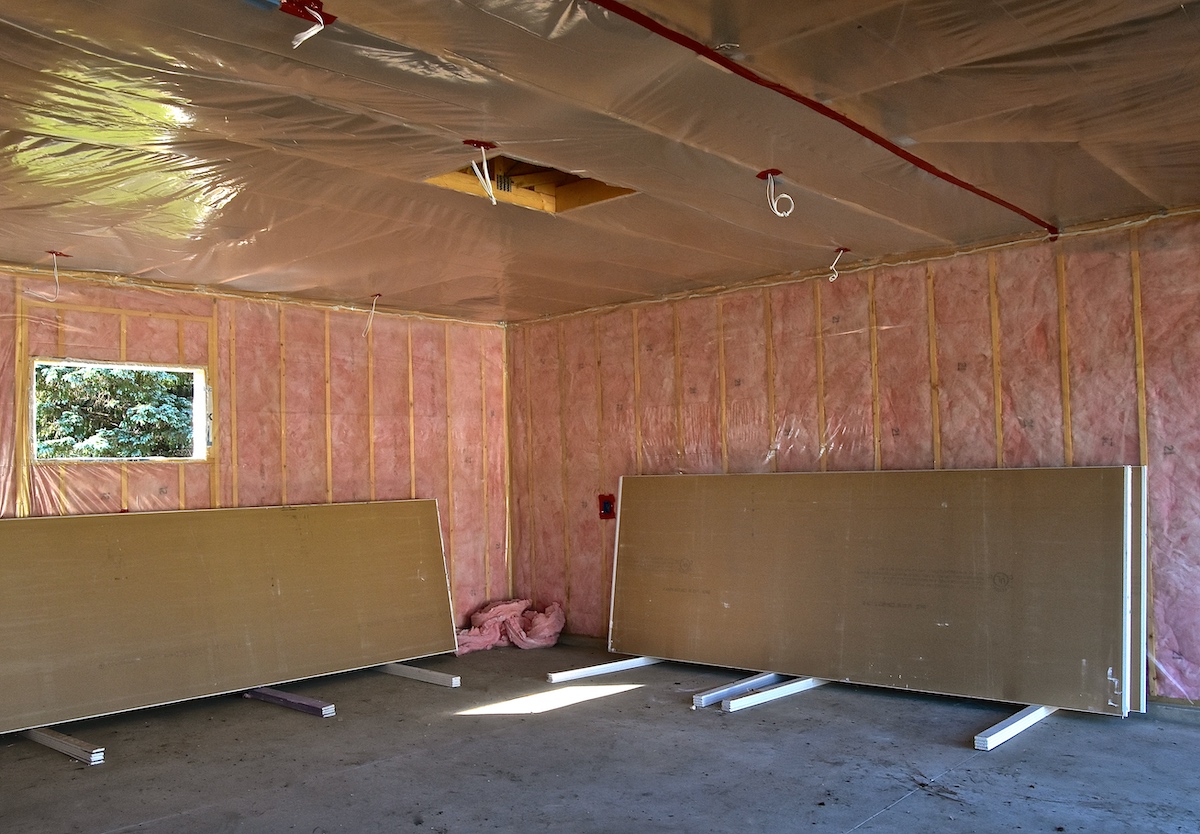
No matter how much power your garage heater packs, you’ll find it difficult to maintain comfortable warmth in your garage if the walls aren’t finished. Many garage walls consist of just the studs, covered on the outside with sheathing and siding. Without garage insulation, cold air outside will quickly transfer to the inside of the garage and detract from your heating efforts.
Insulating a garage is a project that’s easy enough for most homeowners to take on themselves. To create an insulated barrier, install fiberglass batt insulation (such as Johns Manville R-19 fiberglass batt insulation) in each stud space and then finish the interior walls by installing drywall panels, plywood sheets, or oriented strand board (OSB). Insulated and finished walls will help retain heat in the garage, and you’ll save money on heating bills.
3. Insulate the garage door.
Often manufactured from thin metal, garage doors are notoriously cold in winter. In fact, if you live in a northern climate, it’s not unusual to find frost clinging to the inside of a metal garage door. Insulating the garage door will help keep the cold outside air from transferring indoors and cooling the workshop. An insulated garage door can make the space an average of 10 to 12 degrees warmer in winter, even before you crank up any heaters. And the process isn’t so intimidating for do-it-yourselfers, thanks to kits like Reach Barrier’s Garage Door Insulation Kit, which contain all of the necessary supplies. When selecting a garage door insulation kit, be sure to measure your doors carefully. While the Reach Barrier kit will insulate one standard garage door, garages with oversize doors (or two or more doors) will require additional kits.
4. Seal gaps and drafts.
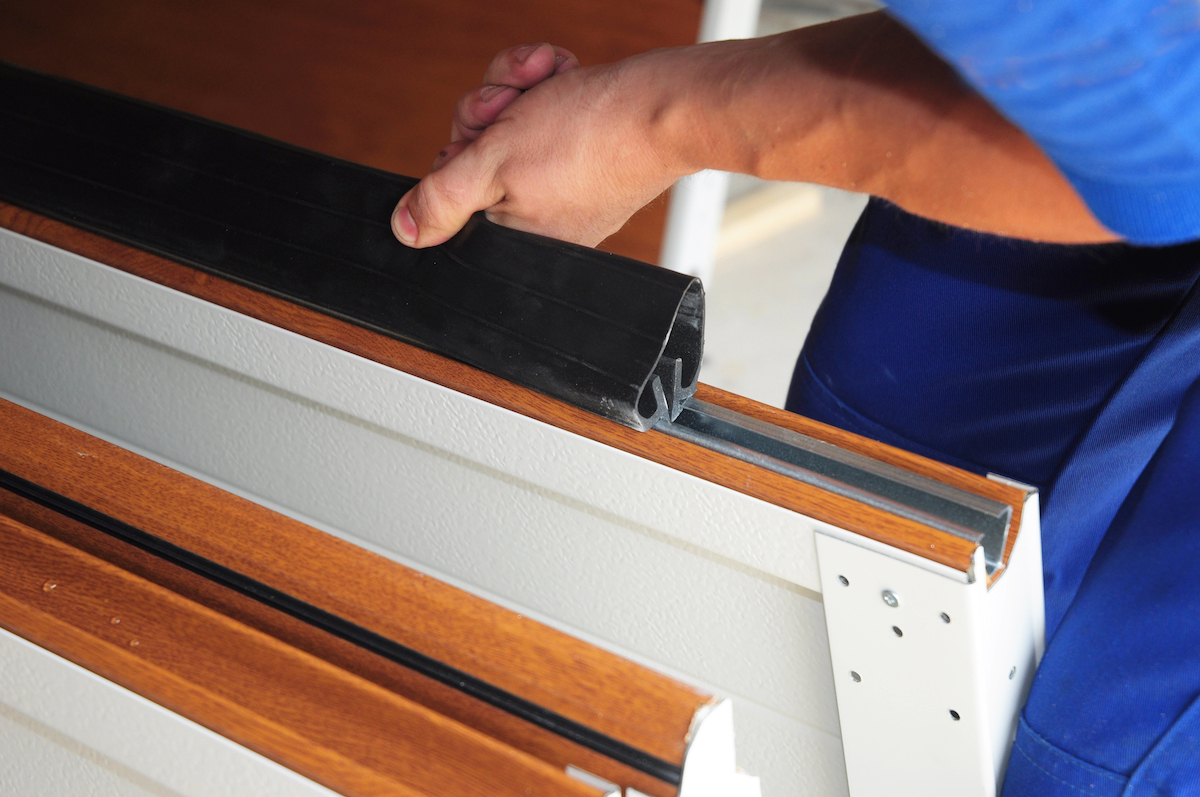
Investing in insulation and heaters will help you keep your garage comfortable in the winter, but you should also seal any gaps that let cold drafts blow through. To get started, take a walk around your garage, focusing on these three most likely sources of drafts.
- The garage door frame: Garage doors don’t fit tightly in their frames—small gaps run all the way around the door. Fortunately, you can quickly address these spots with an integrated weather-strip seal like M-D Building Products’ Vinyl Garage Door Top and Sides Seal. The self-adhesive strips will help close the gaps so cold drafts can’t enter.
- The bottom of the door: If your garage door is more than a couple of years old, it’s also a good idea to replace the seal, or garage door threshold, where the door meets the floor. This seal is designed to block drafts but can become brittle and cracked over time, and start to let the cold air in. Gaskets are available in various sizes to fit different size doors. Measure the width of your door carefully before you choose a replacement such as DGSL’s Bottom Rubber Weather Stripping Kit.
- Windows: To seal drafty windows, apply shrink-type film to the inside of the windows. To install the 3M Window Insulator Kit or other top picks from our tested guide to the best window insulating kits, tape the shrink wrap to the window frame and then use a hair dryer to heat the film until it fits snugly to the frame, sealing out drafts.
5. Install a radiant floor heating system.
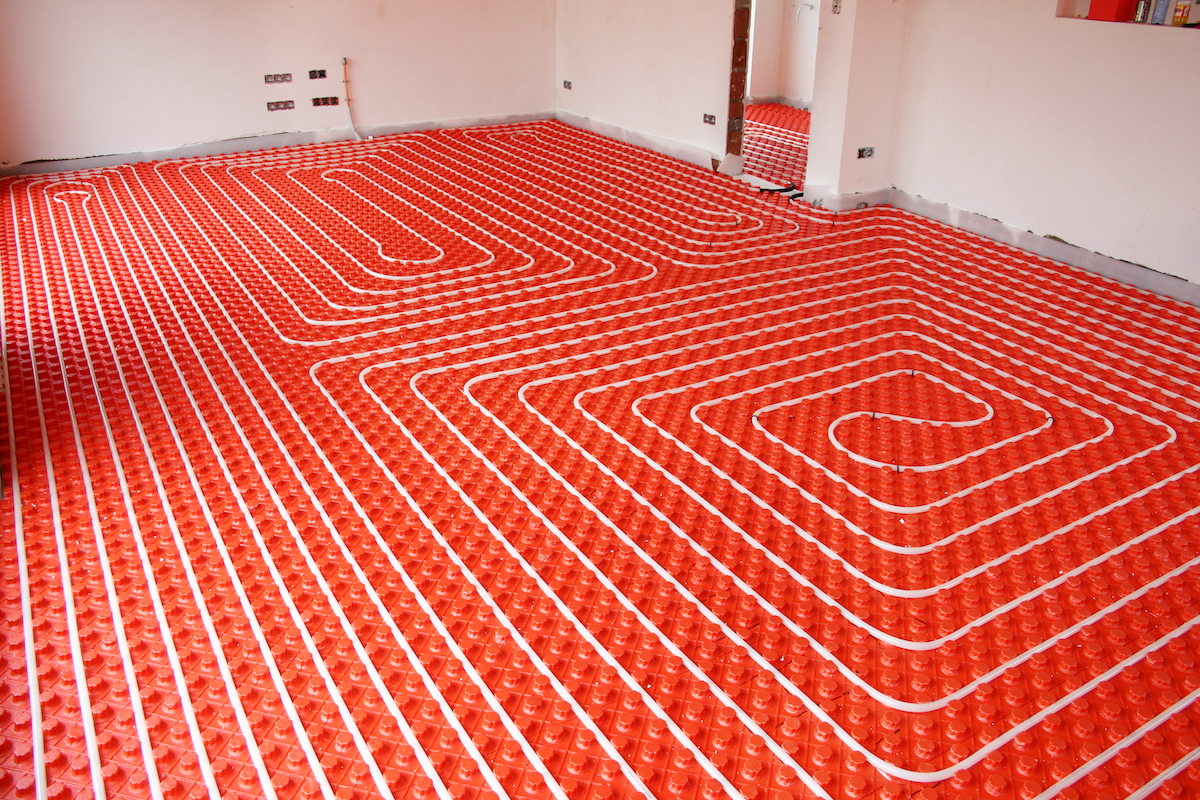
If you enjoy working on your car in your garage, you probably dread having to lie on a frigid concrete floor while changing oil or making repairs. One effective way to remedy this problem is to install a radiant floor heating system. Unfortunately, this is a viable solution only for those who are building a new garage or are planning to tear out and replace an existing garage floor. Radiant floor heating is installed before the concrete floor is poured. The installation process is roughly as follows:
- First, a reflective liner is installed over fill sand in the bottom of the excavated area,
- Flexible piping is positioned in loops over the liner
- The concrete is poured
- The radiant heating system is connected to the boiler, which circulates hot water through the pipes, radiating heat to the floor and the objects above.
If you spend a lot of time in your garage and are thinking of renovating it, this solution may be right for you. It’s not a DIY project. You’ll need to hire a plumber who specializes in installing radiant floor heating systems. The cost to install radiant floor heating is usually about $5 to $9 per square foot for installation, plus the cost of the boiler. The resulting system is ideal for heating a garage workshop: It warms the space without blowing wood chips and dust around as forced-air heating would, keeping your workspace clear of particles that might interfere with detail work.
6. Run a portable propane heater.
Many houses are connected to natural gas lines, but garages often aren’t, and that leaves homeowners with fewer options for heating their garages.
Electric heating is almost always a possibility, but in many regions electricity is pricey. Electric garage heaters also pull a lot of juice, which can cause circuits to overload and breakers to trip, particularly if you’re running a few tools at the same time. Also, relying on electric heat may require additional electrical circuits. For all of these reasons, using a propane heater for the garage may be a reasonably priced alternative. (For our recommended manufacturers and models, read our tested guide to the best propane heaters.)
A standard, 20-pound propane tank can power a small propane heater. If that’s not enough heat, you can opt for a larger 500-gallon tank and have a plumber run a gas line to the garage to fuel a larger propane gas garage heater. Where venting isn’t possible, look for a vent-free propane heater that’s designed to burn cleanly and safely.
7. Warm up with a wood-burning stove.
For those who plan on spending a lot of time in a garage workshop during the colder months, it’s tough to beat the soothing warmth of a wood-burning stove. Not only will a wood burning stove provide heat, but it also adds a cozy ambience to the space. If you have a ready source of wood, this can be among the best options for cheap heat. (Our researched guide to the best wood stoves highlights high-quality stoves at a variety of price points.)
Safety considerations should be top of mind if you decide to install a wood-burning stove in a garage. The stove must be positioned on a nonflammable surface—a concrete garage floor is ideal—and located a safe distance from walls, cabinets, and any flammable or combustible items. Models vary, however, and some of the newer wood-burning stoves feature insulated exterior shells that don’t get dangerously hot.
It’s important to note that a wood stove must be appropriately vented to keep smoke from backing up in the garage. Local building codes come into play here and usually require that a triple-wall stovepipe be installed vertically through the ceiling. Check with your local building authority for additional restrictions.
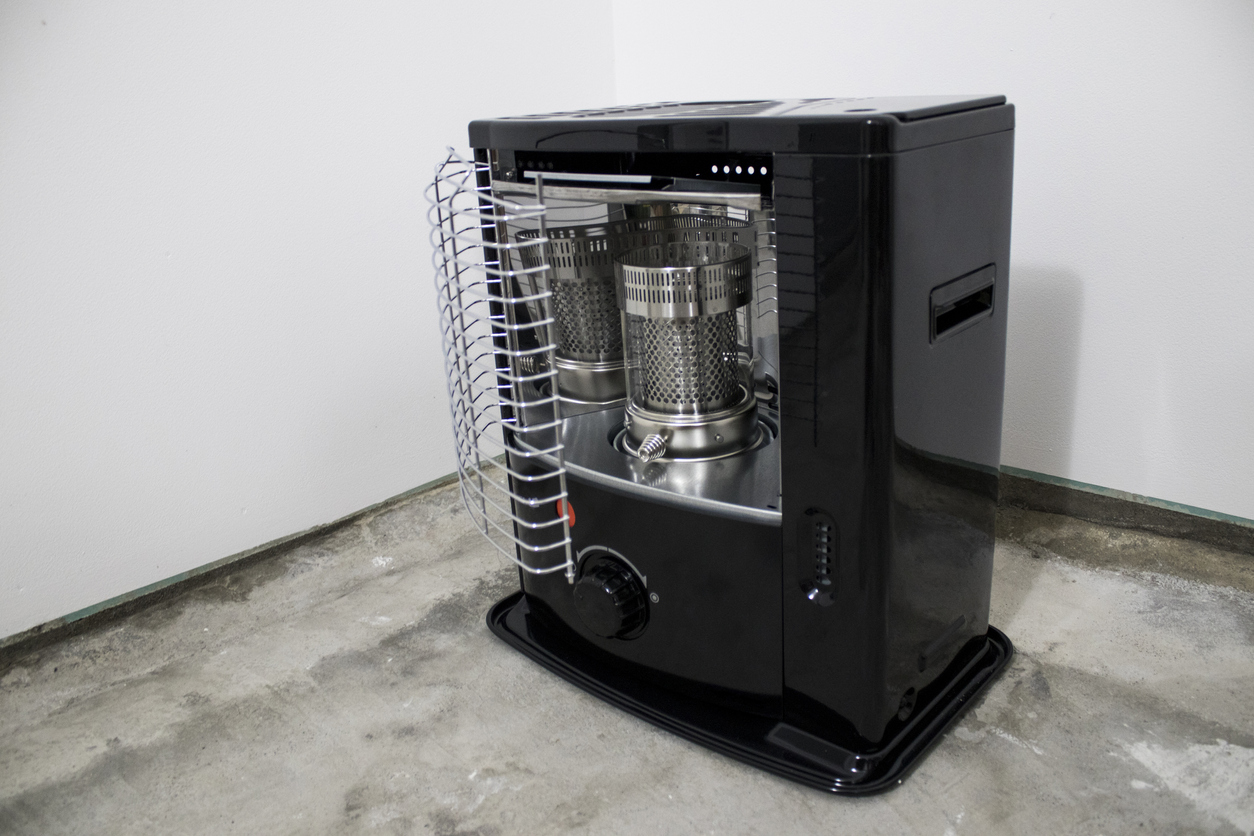
8. Concentrate heat with a kerosene space heater.
Electric space heaters are great for supplemental heating during cold weather, but if a space heater will be the only source of heat in a garage, it should be a powerful one. A kerosene-powered heater fits the bill.
This type of space heater, often called a “torpedo” or “salamander,” generates a lot of heat and concentrates it in a specific direction, so a craftsperson or mechanic at work in the garage can stay nice and warm. Because these heaters often have fans that run on electricity, you’ll still need an electric outlet to run it, but the heat itself is generated by kerosene.
Kerosene space heaters, such as the Dyna-Glo 50,000 BTU Forced Air Heater, a top performer in our tested guide to the top non-electric heaters, can generate up to 215,000 BTUs. That’s a heck of a lot of heat! When selecting a kerosene heater for a garage, buy one that’s designed for indoor use to ensure that it won’t emit toxic fumes. Kerosene torpedo heaters designed for outdoor use may not burn as cleanly, and they are not intended for use in closed spaces. Make sure the model you choose is properly sized for the space in which it’ll be used.
9. Radiate heat.
Some types of heaters blow out hot air that warms up a space, but radiant heat works a bit differently, and it’s among the best options for heating a garage on a chilly day.
Radiant heaters use infrared energy that’s generated in a number of ways, via a heating element, an infrared lamp, or even actual flames. The way they work, however, is fundamentally different from forced-air heat. Imagine standing outdoors on a cold day. When the sun comes out, you immediately feel its warmth—that’s radiant heat—even though the air temperature may not have risen perceptibly.
In a garage or workshop, radiant heaters can be installed overhead or on walls. The Comfort Zone CZQTV5M Ceiling Mounted Radiant Quartz Heater uses two quartz bulbs and a reflective base to radiate heat outward, where it will make you, and everything around you, warm. You’ll be able to work comfortably no matter how cold it gets outside and, thanks to the heater’s built-in halogen light bulb, you’ll be able to see whatever’s on your workbench.
10. Extend your mini-split system setup into the garage.
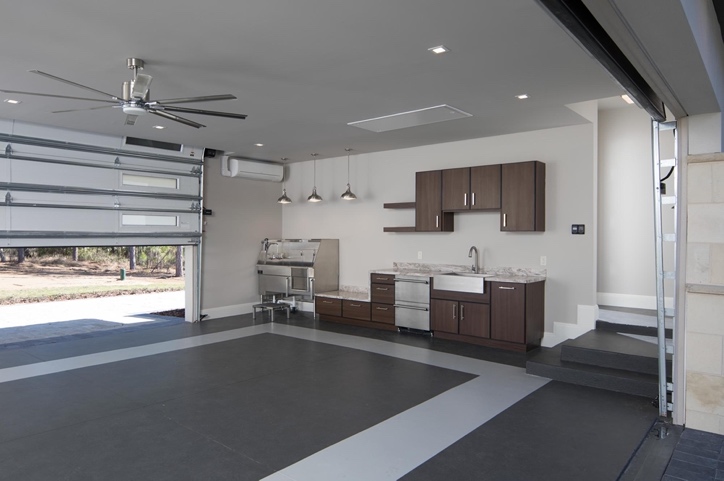
For homeowners who already have a ductless mini-split air conditioning system for heating and cooling, it should be fairly easy to add an indoor air-handling unit to your system if the compressor you have is large enough to handle heating and cooling an additional “room.” If you don’t already have a mini-split system, purchasing a mini-split compressor and indoor unit for your garage is still a terrific option, but doing so will cost you more than a few space heaters will.
11. Reduce thermal transfer with a floor covering.
While heaters and insulation will certainly help keep the air in your garage warmer during the winter, there’s one zone that will still feel frigid: the garage floor. Concrete floors can be bitterly cold, particularly so for anyone who has to scoot under a car or kneel on the floor to work on a project.
Covering the floor is the simplest solution to cold concrete: Consider putting down an indoor/outdoor rug that can be vacuumed or blown clean with a leaf blower. To make a hard concrete floor more comfortable, you might instead install interlocking rubber mats—the kind that’s used for the best gym flooring. These mats both insulate the floor and pad it, making it easier to be on your feet for long periods of time.
